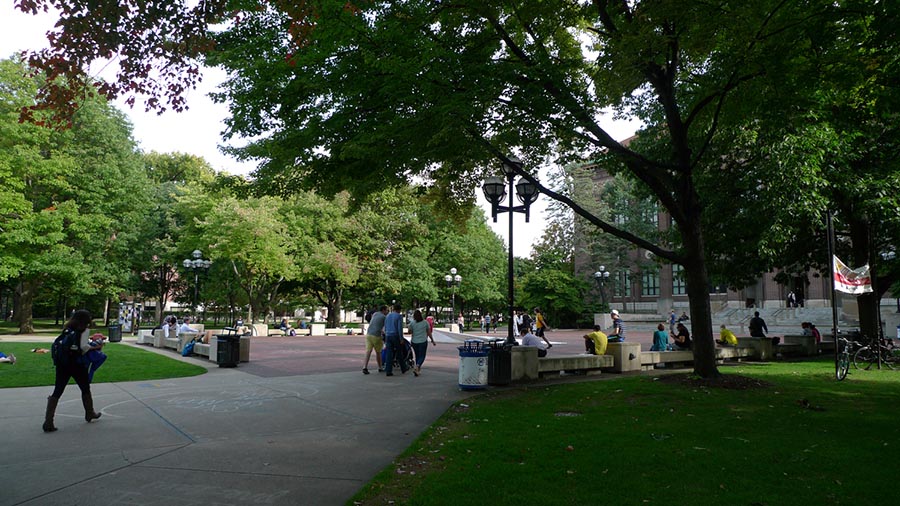Dual enrollment growing in popularity and frustration


Dual enrollment is suffering growing pains. The popular program allows high schoolers to take college courses free, with the incentive that they will apply to a degree program. But opportunities still vary widely between counties, and credits earned come with strings attached at many Michigan universities.
There is no state office assuring that dual-enrollment courses align with requirements at the state’s universities. And because Michigan’s 15 public universities are autonomous, their policies on accepting dual-enrollment credits vary.
Dual enrollment has benefited thousands of Michigan students by giving them an early taste of college and, in many cases, allowed them to earn credits without paying tuition. But frustrations remain for students and families, who often find out later that the credits either aren’t accepted at the university they enroll in, or are counted only as general credits rather than applying toward a major.
Popular here, not there
More than 20,000 Michigan high school juniors and seniors – one in 10 – took at least one college course in 2013-14, the last year for which data is available. That’s more than double the number from 10 years earlier. The fees for those classes were more than $19 million, a cost that would have been borne by the student families without dual enrollment.
“As a trend, it’s definitely changed dramatically,” said David Dugger, executive director of the Early College Alliance at Eastern Michigan University.
There are now more than 100 early/middle college programs in the state, a version of dual enrollment in which students can graduate from high school with both a diploma and an associate’s degree by staying an extra year, Dugger said. Traditional dual enrollment, in which high schoolers take a few college classes that are approved by school administrators, is also growing.
“The exposure to college experience in dual-enrollment classes is invaluable,” said Dugger. Students who take such courses are more likely to graduate from college, particularly those from first-generation families for whom higher education is a foreign experience, Dugger said.
State law mandates that public school districts pay for dual enrollment courses for students if the courses meet certain requirements – that the college courses are not offered at the high school level and are academic, rather than hobby or recreational, for example.
Despite the fact students at all schools are free to take such classes, gaps in participation are troublingly large.
A Bridge Magazine analysis of state data provided by the Early College Alliance found that dual enrollment participation rates among 11th and 12th graders varies by 90-fold across Michigan’s counties – from 89.7 percent in Alcona County in rural northeastern Michigan, to 0.9 percent in the Upper Peninsula’s Baraga County.
Some counties don’t have easy access to colleges that can offer such opportunities. For example, in Livingston County, which has no community college, just 3.5 percent of juniors and seniors took a college course in 2013-14; in neighboring Washtenaw County, home of Washtenaw Community College and the University of Michigan, more than 30 percent of juniors and seniors were taking advantage of dual enrollment.
Access doesn’t explain all the disparities, though. Oakland and Macomb counties both have large community colleges, but their dual enrollment participation rates (3.4 percent in Oakland, 2.9 percent in Macomb) were among the lowest in the state.
Brian Barber, alternative education consultant with the Michigan Department of Education, said that while students at all schools are allowed to apply for dual enrollment, not all schools promote it.
“(Schools in) some counties have embraced the notion of dual enrollment and middle/early colleges, others haven’t,” Barber said. “It becomes an access issue along with a promotion issue.”
Additionally, schools have a financial incentive not to promote dual enrollment: Districts pay its cost out of their own budgets. Every time a student takes a philosophy class at the local community college, it means less money for other school needs.
That doesn’t always mean students are missing out on college credits. “There was less of a need in Oakland and Macomb to put students in dual enrollment,” said Michael Yocum, assistant superintendent at Oakland Schools Intermediate School District “because districts were already offering advanced placement courses that offer college credit, and dual enrollment costs districts money,”
More districts, however, are embracing dual enrollment as a means to introduce kids to college, said John Vanwagoner II, superintendent of Alpena Public Schools. “Most of us in K-12 education have said, ‘It’s the best thing for these students, so we’re going to do it.’”
Credit? What credit?
Some students arrive on college campuses as incoming freshmen with a transcript full of dual enrollment credits, only to discover those credits aren’t all they were cracked up to be.
The state mandates that schools offer dual enrollment, but it doesn’t mandate how universities accept those credits, said MDE’s Barber.
“There is nothing at state level that says what transfers and what doesn’t,” Barber said. “It’s going to be up to the accepting post-secondary institution as to whether or not they accept the credit at face value. There are some schools that may take the credit, but apply it not to the content area but as elective credits.”
Take this example offered by Barber: A student takes English 101 at a nearby community college through a dual enrollment program. The university he or she enrolls in may accept the credits for the course, but only count them toward the total credits needed to earn a degree, instead of toward required courses needed to graduate. “So, sometimes they end up taking a course twice,” once on the taxpayer dime in high school, and a second time out of their own pocket, Barber said.
That’s a common experience for students go through an early college program called ACE (Accelerated College Experience) run by the Oakland Schools Intermediate School District, said Jim Troost, the program’s director.
“I felt good about the credits getting accepted,” Troost said. “Then I got the answer that they all were accepted, but they weren’t counting toward a degree.”
The ACE program is designed for low-income and first-generation students who are at high risk of not completing college. By banking credits before graduating high school, the students have a better shot of earning a college diploma, Troost said.
He’s learned to be careful “not to overpromise” about how the college credits earned in the program will be applied in college. “These early college programs, might not actually be two years of college (credit), it may be one year,” because of how universities count the credits, Troost said.
Jeff Jennette, superintendent of Wexford-Missaukee Intermediate School District and Manistee Intermediate School District, said the situation raises his blood pressure.
“There are many institutions in Michigan that are thwarting efforts of dual enrollment and (credit) transferability,” Jennette said. “I think it is a crime, but no one has the courage in the MDE or the Legislature to stand up to these institutions.”
When universities and community colleges raise tuition, school districts pay larger bills for dual enrollment, Jennette said. Yet the districts have no say over how those same universities accept those dual enrollment credits.
“The districts get burned on tuition and the students get burned on credits,” Jennette said.
But universities are more accepting of dual enrollment credits than in the past, when schools such as the University of Michigan and Michigan State University accepted none. Today, both accept some, with restrictions.
Starting in 2013, the University of Michigan accepts dual-enrollment credits if the class in which they were earned includes high school and college students.
At Michigan State, “Now, if you go to community college and take a course, we try to take that in as long as it it’s not remedial work, and you get a C or better and our faculty determines we have a course equal to the course,” said Mike Cook, senior associate director of admissions.
Early College Alliance’s Dugger has some sympathy for universities, who sometimes feel the courses taken through dual enrollment don’t measure up to those offered on their campuses.
“There’s an assumption that a college credit is a college credit and it’s transferable,” Dugger said. “But in Michigan, institutions generally transfer most credits, but they also have autonomy to make individual decisions regarding specific courses and their transferability."
“The cost of higher education has gone up considerably so everybody is looking for ways to lower their costs,” Dugger said. “So it’s a big economic driver to enter these programs. When you don’t get the economic benefit, I can understand the frustration.”
It’s all about alignment
The frustrations with Michigan’s dual enrollment system revolve around the fact that it isn’t really a system – everyone is doing their own thing, said MDE’s Barber.
“Minus something from the Legislature that’s going to mandate a one-for-one credit transfer, where a kid takes a course for the same number of credits in the same content area at an eligible accredited post-secondary institution gets those credits transferred,” there will continue to be issues, Barber said.
Some states, such as Florida, have course catalogues that are consistent across public universities and community colleges, eliminating the problems with transfer.
“If you want to fix the credit transfer issue, you have to fix the alignment issue,” Dugger said.
University registrars are trying to smooth out the bumps, said Brandy Johnson, of the Michigan College Access Network.
“The Legislature has started to figure out what is happening, and pushed colleges to self-police,” Johnson said.
In the meantime, “I think that there is a responsibility to the high schools and postsecondary partners that provide dual enrollment options to be clear on the transferability of those credits,” Dugger said.
MDE’s Barber emphasized that problems with dual enrollment shouldn’t overshadow the enormous good it is doing for thousands of students.
“Blurring the lines between postsecondary and secondary is great for the students,” Barber said. “A lot of kids used to go to high school their senior year and it was a blow-off year because they had their credits. That is really gone. There’s no reason a student shouldn’t have a challenging senior year now. The trick is how to have the secondary system and postsecondary system become more seamless, with communication, accessibility as well as money.”
See what new members are saying about why they donated to Bridge Michigan:
- “In order for this information to be accurate and unbiased it must be underwritten by its readers, not by special interests.” - Larry S.
- “Not many other media sources report on the topics Bridge does.” - Susan B.
- “Your journalism is outstanding and rare these days.” - Mark S.
If you want to ensure the future of nonpartisan, nonprofit Michigan journalism, please become a member today. You, too, will be asked why you donated and maybe we'll feature your quote next time!
 Students stepping onto campus with dual enrollment credits are sometimes in for an unpleasant surprise. Some credits count, some don’t, and some aren’t counted toward degrees.
Students stepping onto campus with dual enrollment credits are sometimes in for an unpleasant surprise. Some credits count, some don’t, and some aren’t counted toward degrees.